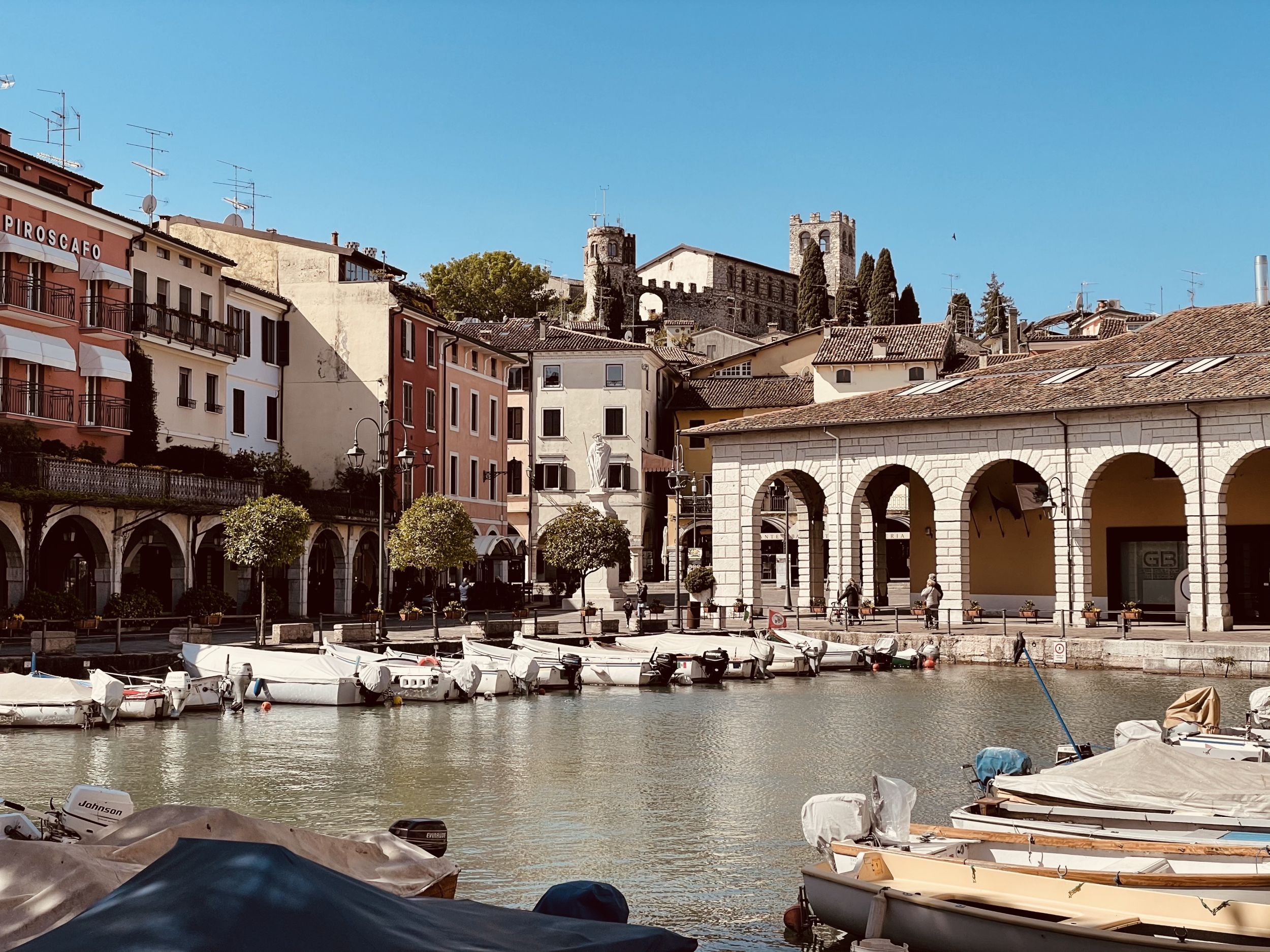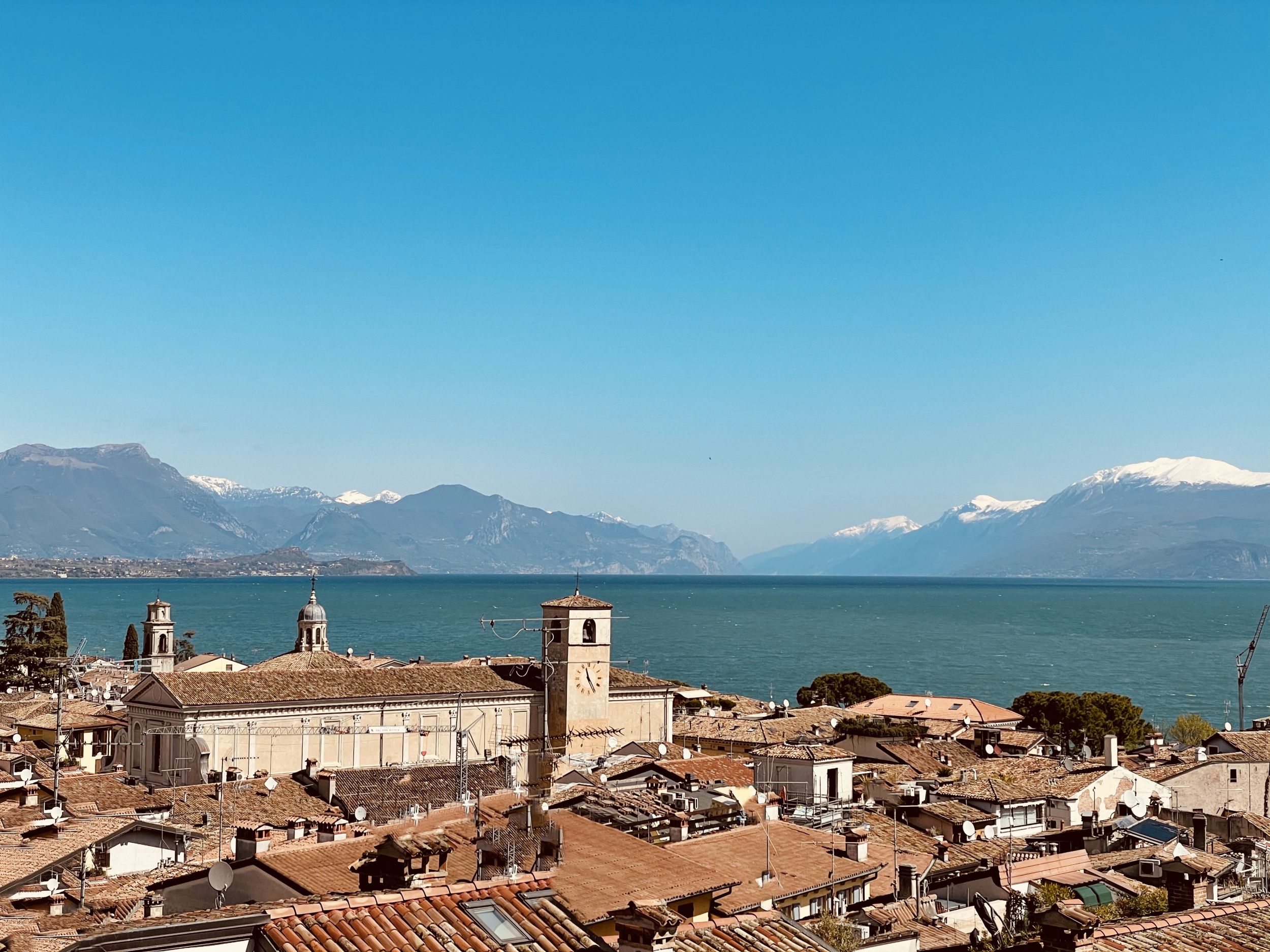Explore Desenzano : a walk in the historic centre
Let's discover Desenzano together !
There are days when I wake up with a thousand thoughts. On days like this, I take time for resetting myself. After a warm cappuccino&brioche, I go through the doors of the hotel, cross the street and reach the lakefront promenade : the Peler, the wind coming from North, blows in the morning.
My walk starts along the lake promenade with its amazing views on Sirmione and the mountains, I walk towards the harbour, along the row of trees to reach the lighthouse.


From the Venetian-style white bridge I turn into the Porto Vecchio, where I always find quietness. Here the light is always amazing: soft and golden in the morning, warm and cheerful from noon to sunset. Sometimes I can see the last fisherman returning with his small wooden boat full of nets.
.jpg)
In front of the old little harbour is Piazza Malvezzi with its long portico: you can smell the scent of coffee and croissants in the air and hear the voices of those working in the shops of the center, greeting each other before starting the day. On the right there is the Cathedral of Santa Maria Maddalena, with paintings by Andrea Celesti and Tiepolo,inside the church on the left there is an apse with a Madonna: she has such a kind and sweet face…when it happens to me to enter, it is always in front of her that I stop for making a wish.
The Cathedral:
Designed by architect Giulio Todeschini of Brescia (1524-1603) and built between 1586 and 1611, the cathedral is dedicated to Santa Maria Magdalena. Inside there are works by Andrea Celesti (1637-1712), Gian Battista Tiepolo (1669-1770), Zenon Veronese (1484-1553), Palma il Giovane (1544-1628), Andrea Bertanza and Pietro Calcinardi. The high altar with sumptuous marble inlays was supposedly made by the studio of Santo Calegari

Around the main square there are a few narrow streets to go up to the Castle, the most popular is via Castello with its colorful houses and its shops. But the most secret is the one that begins where La Stella Restaurant is located.

That is for true Desenzano locals: it is steep path and reaches the Castle in a moment but you can't miss it.
From the terrace in front of the Castle, the view on the lake is wide : from the Sirmione peninsula up to the western coasts descending to the lake.
It is a impressive view !
The Castle:
The Castle is the building that characterizes the appearance of Desenzano whether you see it coming up from the hinterland, whether you look from the harbour or away from the lake. At the end of the 15th century the castle, which originated in the early Middle Ages and probably was built on the foundations of a Roman castrum, was expanded in the south part, but never became a military fortress, even if the magnification was made to house a garrison.It continued to perform the function of refuge for the population.
Of the castle remain some pieces of curtain walls with crumbled battlements among the four corner towers, with the exception of that one on the north-east edge which, until 1940, worked as an observatory. From its terrace one can enjoy one of the most beautiful views of Lake Garda.

Then I go back down to the centre down along Via Castello , direction Museo Rambotti : did you know that the most ancient plug in the world is here ?
Opened in 1990, it displays the finds come to light in the Polada peat bog between Desenzano and Lonato, and in the area of Lavagnone, an ancient pile-dwelling settlement about 5 km south of the town. In addition to ceramics, flint arrowheads, weapons and utensils, there is also a large wooden plough from the Bronze Age (around 2,000 B.C.). It is a particularly interesting piece on account of its size -- one of the two pieces measures 2.20 m -- and its excellent condition.


Back to Malvezzi square , going from Preistoric era to Roman era , we reach the Villa Romana with its wonderful colored mosaics, which are a rarity for that historical period. Every time I go there I think that yes, that Roman Lord who had built this beautiful villa had just guessed it: in Desenzano you live well ... the Romans grasped this truth many centuries ago!
The Roman Villa:
Discovered in 1921, the remains of the Villa extend over one hectare. It is considered the most important example in Northern Italy of ancient grand villas. The construction began in the 1st century A.D., and it was finally completed at the beginning of the 4th century. Besides the "Antiquarium" with sculptures, necklaces, utensils, oil lamps, brooches, etc., other points of interest are the octagonal vestibule, the peristyle, the entrance hall, the sumptuous "aula trichora" and the "viridarium", completed with a nymphaeum. The magnificent mosaic floor is decorated with scenes of hunting, fishing and farming.



My need for positive energy and broader horizons has been regenerated even today : the desire for letting you discover our Desenzano is always strong, because its beauty, its history and its life are truly able to take your mind off the things and to get you ready for a perfect start of the day.
Request Informations

Lungolago Cesare Battisti, 17 - 25015 Desenzano Del Garda (Bs) Italy
T.+39 030/9143495 - reception@parkhotelonline.it
P.Iva 03167750987 - CIR 017067-ALB-00017 | CIN: IT017067A1U8KKL3XL
Privacy & Cookie Policy - Cookie preferences
T.+39 030/9143495 - reception@parkhotelonline.it
P.Iva 03167750987 - CIR 017067-ALB-00017 | CIN: IT017067A1U8KKL3XL
Privacy & Cookie Policy - Cookie preferences
Credits TITANKA! Spa














